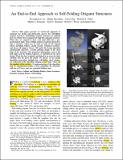An End-to-End Approach to Self-Folding Origami Structures
Author(s)
An, Byoungkwon; Miyashita, Shuhei; Ong, Aaron; Tolley, Michael T.; Demaine, Martin L; Demaine, Erik D; Wood, Robert J.; Rus, Daniela L; ... Show more Show less
DownloadSubmitted version (3.426Mb)
Terms of use
Metadata
Show full item recordAbstract
This paper presents an end-to-end approach to automate the design and fabrication process for self-folding origami structures. Self-folding origami structures are robotic sheets composed of rigid tiles and joint actuators. When they are exposed to heat, each joint folds into a preprogrammed angle. Those folding motions transform themselves into a structure, which can be used as body of 3-D origami robots, including walkers, analog circuits, rotational actuators, and microcell grippers. Given a 3-D model, the design algorithm automatically generates a layout printing design of the sheet form of the structure. The geometric information, such as the fold angles and the folding sequences, is embedded in the sheet design. When the sheet is printed and baked in an oven, the sheet self-folds into the given 3-D model. We discuss, first, the design algorithm generating multiple-step self-folding sheet designs, second, verification of the algorithm running in O(n² ) time, where n is the number of the vertices, third, implementation of the algorithm, and finally, experimental results, several self-folded 3-D structures with up to 55 faces and two sequential folding steps. Keywords: actuators; control engineering computing; design engineering; grippers; mobile robots; shape memory effects; sheet materials; solid modelling; structural engineering computing; multiple-step self-folding sheet designs; sequential folding steps; end-to-end approach; self-folding origami structures; fabrication process; robotic sheets; 3-D origami robots; layout printing design; sheet design; 3D model; walkers; analog circuits; rotational actuators; microcell grippers; Mobile robots; Smart Devices; Actuators; Fabrication; Solid modeling; Three-dimensional displays; Geometry; Three-dimensional printing; Cellular and modular robots; printable origami robots; self-folding; smart actuators
Date issued
2018-12Department
Massachusetts Institute of Technology. Computer Science and Artificial Intelligence LaboratoryJournal
IEEE Transactions on Robotics
Publisher
Institute of Electrical and Electronics Engineers
Citation
An, Byoungkwon et al. "An End-to-End Approach to Self-Folding Origami Structures." IEEE Transactions on Robotics 34, 6 (December 2018): 1409-1424
Version: Original manuscript
ISSN
1552-3098
1941-0468
Keywords
Control and Systems Engineering, Electrical and Electronic Engineering, Computer Science Applications